What is Laparoscopic A.I.?
Laparoscopic A.I. was introduced in South Africa in 1985 by dr. J.J. Steyn and ever since has a steady increase in demand. It is a specialised technique to be performed by a well-trained veterinarian and RAMSEM has four highly trained and experienced veterinarians available to perform this procedure throughout the country, namely dr. Johan Steyn and his two sons, drs. Fanie and Thomas Steyn, and dr. Wynand van der Merwe.
Laparoscopic A.I. is intended especially in the sheep-ewe where the cervix cannot be penetrated with a normal artificial insemination pipette because of cross-pleating inside the cervix. The consequence is that not enough sperm can move through the cervix, leaving a negative result on conception and fertilisation. Better results can however be achieved with goat semen due to deeper cervix penetration.

Advantages
Sheep and goat breeders can utilise laparoscopic A.I. very successful in their breeding programs. A skilled operator can inseminate up to 300 ewes per day with either fresh or frozen semen. When fresh semen is used approximately 100 – 200 ewes can be inseminated by using only one ram. 20 million live sperm are needed for Laparoscopic A.I. versus 120 million for cervical A.I.
When frozen semen is used, any amount of ewes can be inseminated and several co-owners of an expensive ram can still make full use of the ram.
Frozen semen is a good insurance for a ram. Semen is preserved in liquid Nitrogen and can be stored for several years.
Semen can be distributed and used throughout the country which makes rapid genetic progress possible.
With frozen semen in stock, breeders know exactly how many doses of semen are available, AI programs can therefore be planned and executed properly.
Superior rams’ semen is available for all breeders.
Disadvantages
In general, Laparoscopic A.I. can be seen as an expensive technique for commercial sheep- and goat breeders.
Equipment for Laparoscopic A.I.
- Endoscope light source and fibre optic cable
- Two sets of trocars and cannulas
- A medical CO2 cylinder with pressure valve and latex tubing (to inflate abdomen).
- Transcab and Aspics (to draw semen in and to deposit it with a short sharp needle into the lumen of both uterine horns of the ewe).
- Special manufactured trolleys (to restrain ewes on their backs and to tilt them at 45° with hindquarters elevated).
Laparoscopic A.I. Technique
Ewes have to be starved for at least 12 hours before the procedure, the reason being, to reduce the content of the rumen and the bladder. The abdomen is then prepared by shearing, shaving and disinfecting. The trocars and cannulas are inserted 7 – 10 cm ventral to the udder and 5 – 10 cm on each side of the mid-ventral line.
A scalpel blade can be used to make a small incision in the skin to facilitate penetration. The 7 mm trocar and cannula that is connected with the CO2 is first introduced and the abdomen is slightly inflated to create space in the abdomen and to reduce the chance of injury to organs.
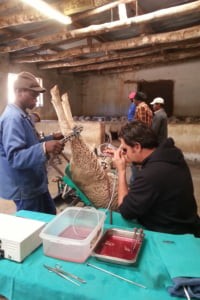 Insertions of the first trocar and cannula should be well controlled. The sharp trocar must be withdrawn as soon as the abdominal wall has been pierced. The blunt cannula is pushed well into the abdomen and the second trocar and cannula is inserted after inflation with CO2. The Endoscope and AI instrument go through the cannulas while the uterus is located just ventral to the uterine bladder. Semen is then deposited into each uterine horn approximately halfway between the uterine bifurcation and the utero-tubal junction.
Insertions of the first trocar and cannula should be well controlled. The sharp trocar must be withdrawn as soon as the abdominal wall has been pierced. The blunt cannula is pushed well into the abdomen and the second trocar and cannula is inserted after inflation with CO2. The Endoscope and AI instrument go through the cannulas while the uterus is located just ventral to the uterine bladder. Semen is then deposited into each uterine horn approximately halfway between the uterine bifurcation and the utero-tubal junction. 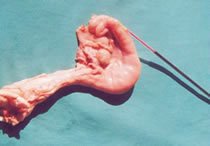 A light stab action of the aspic and the turn of the plunger deposit about 0,1 ml of diluted or frozen thawed semen into the lumen of each uterine horn (total 0,2 ml). Instruments are withdrawn and an antibiotic spray is applied immediately onto the two small wounds. Instruments are keps in disinfectants throughout the whole process.
A light stab action of the aspic and the turn of the plunger deposit about 0,1 ml of diluted or frozen thawed semen into the lumen of each uterine horn (total 0,2 ml). Instruments are withdrawn and an antibiotic spray is applied immediately onto the two small wounds. Instruments are keps in disinfectants throughout the whole process.
Occasional bleeding may be caused by perforation of a subcutaneous blood vessel. The wound can be sutured or an artery clamp is applied. Fatalities can occur when the abdominal aorta is pierced with an uncontrolled insertion of the first trocar. It is possible to pierce a full rumen as well as a full bladder. It is essential that operators should be well trained.
Success of Laparoscopic A.I.
When the program is planned it is important for the breeder to work closely with the A.I. Centre as well as the Veterinarian to achieve the best results. To achieve successful reproduction, there are 4 basic requirements to follow, namely:
- The presence of healthy live sperm
- The release of healthy ova by the ewe
- A favourable environment for the bonding of the sperm and ovum so that fertilisation can take place.
- A favourable environment where the fertilised ovum (Zygote) can grow and develop.
Weaknesses in one or more of these basic requirements can lead to poor results of the program.
Preparation of the Ewe
The management of the ewe flock, along with a favourable environment will determine the production of enough healthy ova (egg-cells) for the fertilisation and the development of the embryo.
As soon as the breeder plans his program, he must select ewes for each specific ram.
Fertile ewes with a good breeding history give the best results. Ewes which do not lamb regularly cannot be cured with A.I.. Such infertile ewes are usually large, in good condition and can easily land in the A.I. group. Breeding records must thus be thoroughly checked before bringing ewes into an A.I. program.
Conception rates might be slightly lower in young and very old ewes as compared to mature adult ewes. Young ewes can however be inseminated successfully if they are well selected, well grown and in good condition.
All ewes with poor and damaged udders must be excluded so that “multiple births” can be reared successfully.
Semen Quality
RAMSEM Artificial Insemination Centre’s aim is to produce good quality semen after freezing. If semen is frozen elsewhere, imported or privately stored, it must first be evaluated with a good phase-contrast microscope to ensure that the quality of semen is good
Condition and feeding
Condition and feeding of ewes remains the most important factor in reproduction. The positive effect of flush feeding and an increase in body mass 3 – 4 weeks before A.I., is well known. It increases ovulation rate and give better conception rates, it thus pays to feed the ewes at this stage.
In spite of good grazing and roughage, ewes must also get supplementary feeding in the form of balanced licks or concentrates. Drought survival feeding is not enough, the breeder needs to find the right balance between quality protein, energy, essential minerals and vitamins, consult an expert if necessary.
It is important that ewes do not suffer from low body condition and bad feeding during the 6 months prior to A.I.. Development of oocytes under influence of reproductive hormones takes about 6 months – flush feeding 6 weeks before A.I. won’t rectify the problem.
Ewes that reached optimal condition before the A.I. program, must be maintained in that condition and not be allowed to drop in condition before they are inseminated. Flush feeding is of very little value in the case of ewes in optimal conditions.
A good stockman knows his flock and can see how they respond to feeding. By weighing his ewes he will be able to judge very accurately how they are responding.
A concept that should become part of any stock farmers management is condition scoring. The loin area of the ewe is felt while the ewe is standing. Note is taken of the amount which the spinous processes protrude. The fullness of the eye muscle is first concave 1 – 2½ (hollow), becomes level 2½ – 3½ and later becomes convex 3½ – 5 (round). A condition 3½ – 4 is ideal for a ewe prior to mating and 2½ – 3 prior to lambing.
CONDITION SCORING IN SHEEP
| FEATURE | SCORE | ||||
|---|---|---|---|---|---|
| 1 | 2 | 3 | 4 | 5 | |
| Spines | Individually clearly felt, sharp obvious | Form a smooth line with deep undulations | Only slightly detectable undulations | Only slightly detectable with firm pressure | Undetectable |
| Transverse Processes | Fingers easily pass underneath | Smooth, round edges | Well covered Have to push firmly to get fingers underneath | Cannot be felt at all | Cannot be felt at all |
| Muscle | Very little concave | Concave | Not concave nor convex | Maximally developed. Convex | Maximally developed. Convex |
| Fat Layer | None | Very thin | Moderate | Thick | Very thick to form a dip along top midline |
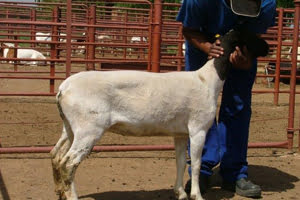 | 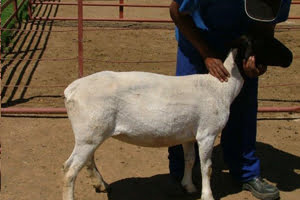 | 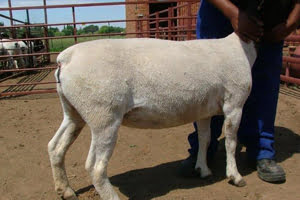 | 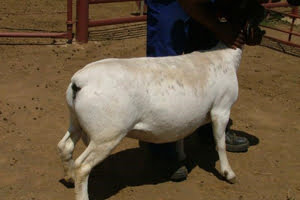 | 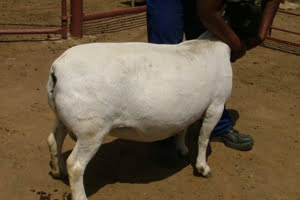 | |
Overweight ewes usually deliver poor results; therefore, the advice of a nutrition specialist may be necessary to ensure that the ration fed is balanced since imbalances in feeding may cause problems during any phase of reproduction, even under intensive conditions imbalances can easily occur. In certain areas Selenium, Copper and Cobalt, must be considered as routine supplement, whereas vitamin A is equally important and should be administered at least 6 weeks before breeding.
Vaccinations, dosing and dipping
Blue tongue, Enzootic abortion and Pasteurella vaccinations must preferably be done six weeks prior to the start of the A.I. program. Dose at the start of flush feeding and try not to handle the ewes for six weeks after insemination. If ewes are on pastures during the late summer it might be necessary to dose them again just prior to inseminating i.e. at sponging or on sponge withdrawal.
After insemination ewes must be placed in a worm-free environment, as heavy worm infestations after A.I. could lead to resorptions.
N.B. This is especially important during spring and with heavy rains
Shearing of ewes
Short wool ewes react better to flush feeding and synchronisation and is easier to handle. It is suggested that insemination is postponed till six weeks after shearing.
Blowfly strike during the breeding season can lead to problems, therefore crutching is recommended with long wool sheep.
Weaning
Lambs must be weaned at least 6 weeks before mating to enable the ewes to recover sufficiently. If, however the ewes lamb every 8 months or in cases where the ewes are still suckling lambs, feeding is of great importance.
Oestrus synchronisation
Laparoscopic insemination involves a single fixed time insemination, so it is dependent on the effectiveness of oestrus synchronisation. Oestrus synchronisation is achieved by placing progesterone treated sponges in the vagina of the ewe and left there for 13 – 15 days. On sponge withdrawal, the ewes are injected with Pregnant Mare Serum Gonadotrophin (P.M.S.G.).
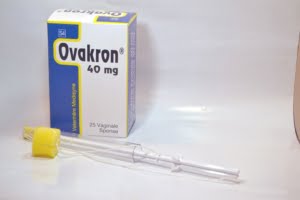 The progesterone sponges prevent the ewes from coming on heat while they are in the vagina of the ewe. The P.M.S.G. exerts a Follicle stimulating hormone and Luteïnising hormone effect, which acts to stimulate the ewes to show oestrus over a short time and may increase the number of multiple ovulations.
The progesterone sponges prevent the ewes from coming on heat while they are in the vagina of the ewe. The P.M.S.G. exerts a Follicle stimulating hormone and Luteïnising hormone effect, which acts to stimulate the ewes to show oestrus over a short time and may increase the number of multiple ovulations.
If two groups are to be inseminated on consecutive days, they can be sponged together and then withdrawn on two separate days. The sponges would then have been left in for 13, 14 or 15 days respectively.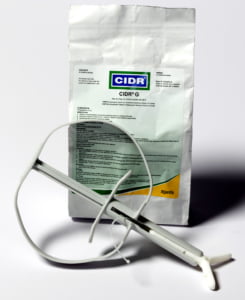
On withdrawal the sponge will be full of mucous and have an offensive smell. If good hygiene was practised during sponging, it will not have any negative effect on conception rates. The ewe will be clean when she comes on heat.
P.M.S.G. administration and dosage
P.M.S.G. is a freeze-dried powder and the dosage administered is expressed in international units (i.u.), which is then converted to volume. There are different kinds of P.M.S.G., for example 6000 i.u. Chonogest or 5000 i.u. Novormon and it is ot utmost importance to consult with your AI Centre for the correct dosage. P.M.S.G. must be dissolved in a sterile solution immediately before use.
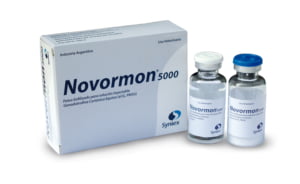 P.M.S.G. is sensitive to temperature changes and must be kept cool (5 – 10 ° C). Once the solution has been made, it must be protected against sunlight and heat and used within 48 hours. Accuracy is essential, and administration is intramuscularly (the thick rump muscle behind the hip bones and in front of the pin bones is easier to reach than the thigh muscle).
P.M.S.G. is sensitive to temperature changes and must be kept cool (5 – 10 ° C). Once the solution has been made, it must be protected against sunlight and heat and used within 48 hours. Accuracy is essential, and administration is intramuscularly (the thick rump muscle behind the hip bones and in front of the pin bones is easier to reach than the thigh muscle).
It is essential to use P.M.S.G. to ensure good synchronisation. At high doses it can stimulate multiple ovulations, which could lead to multiple births. ` The dosage of P.M.S.G. can be lowered when a ewe flock has a history of high conception rates, a good percentage of multiple births on first cycle, is in a good nutritional status and is being mated during its natural mating season. When the opposite conditions are prevalent in a flock with a poor breeding history, deprived nutritional status and outside its natural mating season, the dosage may be increased.
Breeders wanting to increase the number of multiple births can also inject a higher dose.
For Merino ewes we recommend 300 i.u., for heavy mutton breeds 360 – 480 i.u. and for Angora goats 180 – 240 i.u. – depending on age, nutritional status, breeding history and breeding season. It is important for the breeder and inseminator to communicate about this result and reach a final decision.
P.M.S.G. is always administered intramuscularly and at the same time of sponge withdrawal.
The time between sponge withdrawal and insemination is very important, since ovulation takes place from about 56 – 60 hours after sponge withdrawal and it is important to inseminate before that, especially when fresh semen is used. Maiden ewes usually ovulate earlier and some differences between breeds and seasons may occur.
When CIDRs is used, ewes come on heat and ovulate four hours earlier than is the case with sponges.
Teaser rams
Before introduction of teaser rams, it is good practice to ensure that females have no contact with males, including sight or smell, for at least two months.
The stimulatory effect of the presence of teaser rams in a natural mating situation is well known. When synchronising ewes, teaser rams still have an effect and it has been found that ovulation takes place a couple of hours earlier when teaser rams are present. It is recommended that teaser rams (2 – 5 %) are placed with the ewes the afternoon before insemination, where they can be left with the ewes till after insemination.
Teaser rams can be used to mark the ewes as they come on heat and as they are marked, they are removed from the group. The group that comes on heat first, are inseminated first. This is of importance when all the sponges are withdrawn at the same time.
The use of teaser rams with markers help to give an indication of how well the group has responded to the synchronisation. If 50 % of ewes are marked at 36 hours and
80 % at 48 hours, the response has been good. When inseminating over a number of days, it is advisable to have teasers with the first group. This will help to give an indication of how the whole group will respond.
The markers on the teaser rams must be checked regularly to ensure that they still have sufficient wax. Any marked ewes that are to be removed, must be done as quietly as possible. Teaser rams must be rotated to allow them to rest, drink and feed.
If teaser rams are not available the ewes may be placed next to rams or aprons can be fitted to the rams. In both cases they must be kept under observation to prevent any ewes being served.
Fasting
The ewes due to be inseminated must be kept away from food and water for 12 – 18 hours before insemination, this makes the process easier and prevents the ewe from aspirating rumen fluid.
Under veld and lick conditions 12 hours of fasting will be sufficient, whereas under pasture or concentrate conditions an 18-hour period is necessary.
Requirements – Work area
Insemination must be done indoors where there is shelter from sunlight, wind and dust.
The ewes are loaded onto trolleys with wheels and a solid, preferably cement floor is necessary for free movement of the trolleys.
Two or three small camps adjacent to the work area are necessary to enable ewes to be handled easily.
A reliable 220 V power source is required and if a lighting plant is to be used, it must generate at least 1,5 KW.
A work area the size of a double garage is required. Two kitchen type tables and a chair must also be provided.
Labour requirements
The undertaking is fairly labour intensive and the following labourers are required:
- Shearing of ewes: 1 – 2 persons (shearing to be done just before the procedure to insure the abdomens are clean)
- Loading of ewes onto trolleys: 2 persons
- Unloading ewes: 2 persons
- If manpower is limited, two persons could handle the loading and unloading.
- Lifting and holding the ewe during insemination: 1 person.
Depending on facilities and ability of the labourers 6 to 8 people are required for the whole operation to run smoothly.
Post insemination care
Immediately after insemination the ewes must be kept in a holding kraal for around 30 minutes and then released as a group. They can be watered and fed immediately, while the teaser rams remain with them till the following morning. Implantation of the foetus takes place 21 days after fertilisation.
If the ewe is placed under any additional stress during this time, there is a chance of resorption of the embryo. It is not needed to pamper the ewes, but do not subject the ewes to factors such as a sudden drop of nutrition, making them walk long distances, shearing, dipping and dosing.
If the ewes must be transported over short distances it is possible to do so after a couple of days, but do not overload the truck, do not transport them in the heat of the day and do not transport them for long distances for at least 6 weeks.
Follow up rams
The oestrus cycle in sheep is 17 days (15 – 20 days) and about 21 days in goats. It is recommended that follow up rams are put with the ewes from day 14 to 21 (sheep) after the A.I. program.
During the natural mating season, February to May, the ewes that do not conceive normally, show heat on the next cycle. Whereas during the period August to December the ewes tend to go into a period of anoestrus for a couple of cycles after being synchronised. The non-return rate is therefore not a good indication of conception and during the spring mating season it is good practise to keep the follow up rams with the ewes for 2 cycles (34 – 42 days) after insemination.
Pregnancy can be determined after 6 weeks with ultrasonic scanning. If results of the follow-up rams are also wanted, scanning must be done 9 – 10 weeks after insemination. The use of the scanner is a great management support since it can determine multiple pregnancies.
Lambing time
The average gestation time is 150 days, but lambing can occur from day 145 – 155 days after conseption, with the majority lambing happening during the middle three days. Lamb mortality within the first three days is associated to the concentration of ewes per camp and the number of lambs born per day, it is thus advisable to use larger camps or divide the ewes into smaller groups.
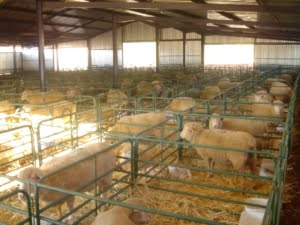 It is crucial to make sure that ewes have enough water, food and shelter within this time. Camps with bushes are useful, since the ewe can separate herself from the group and ensure good binding with her lamb/s. In more intensive systems, lambing crates can be used where the ewe and lamb can be kept under observation.
It is crucial to make sure that ewes have enough water, food and shelter within this time. Camps with bushes are useful, since the ewe can separate herself from the group and ensure good binding with her lamb/s. In more intensive systems, lambing crates can be used where the ewe and lamb can be kept under observation.
It is vital to inspect the ewe flock regularly to lend assistance if any ewes have problems with lambing (especially maiden ewes) and to ensure that new born lambs receive colostrum within 2 – 3 hours (it is advisable to have some frozen colostrum available). When multiple births are expected, weak lambs can be dosed with colostrum using a stomach tube. A dog urinary catheter which is available from a veterinarian is ideal for this. The daily requirements of colostrum are up to 200 ml / kg / day. It is sensible that milk replacers should not be used during the first day as they do not supply the required antibodies.
Admin
- Program:
When the date and number of ewes has been finalised, you will receive a complete program. The number of ewes might not remain exactly the same, but if they do change significantly, or the program is to be cancelled, please advise the inseminator immediately.
- Synchronisation, drugs and semen:
Synchronisation drugs must be ordered well in advance. It is also necessary to order the exact number of frozen semen if necessary.It may be good practise to sponge a few extra ewes to take into account for lost sponges and any ewes becoming ill. Please get in touch with the A.I. Centre immediately when any problems occur.
Scan or lambing results: Please give feedback to the A.I. Centre.
Conclusion
Laparoscopic insemination with fresh or frozen semen has become an essential and integral part of controlled breeding of sheep and goats and provide valuable practical opportunities to improve reproduction efficiency and to enhance genetic improvement. Please contact RAMSEM for more information.

